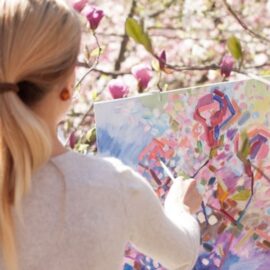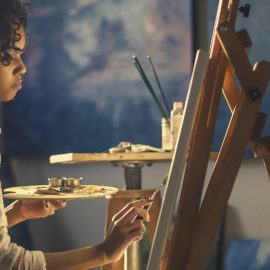

This article gives you a glimpse of what you can learn with Shortform. Shortform has the world’s best guides to 1000+ nonfiction books, plus other resources to help you accelerate your learning.
Want to learn faster and get smarter? Sign up for a free trial here .
Do you want to be more innovative? What are the benefits of creative thinking?
Creative thinking isn’t limited to just musicians, writers, and other artists. Creativity is a valuable tool for anyone to have in everyday life. When you stimulate your creative genius, you discover innovative ideas and find alternative solutions to problems.
Here are some of the benefits you’ll receive when you begin thinking creatively.
What Is Creativity?
In Big Magic, Elizabeth Gilbert defines creativity as the search for and excavation of universe-endowed gifts that are within us, hidden from our view. Our gifts are the talents, interests, and desires that make us us. You can have a gift for anything—stargazing, website design, or mushroom hunting, for instance—not just a traditionally artistic pursuit, like painting, writing, or performing.
In practice, Gilbert’s idea of searching for a gift and becoming creative might look something like this: All your life, you’ve felt that you get along well with animals. You’re not sure why, but it seems as though you can understand them better than other people can. Finally, after years of feeling this way, you decide to test out your hunch by volunteering at your local animal shelter. To your delight, you find that the shelter animals do indeed respond well to you. You are great at training them, playing with them, and bonding with them. Injured or abused animals grow healthier under your care. You have just excavated a creative gift that has always lived inside you, but which you never before searched for.
Notice that Gilbert does not define creativity as a professional pursuit or even as the main goal or mission of one’s life. It’s simply a commitment to exploring your depths and bringing to light the unique powers that exist within you.
Other Definitions of Creativity
Gilbert’s conception of creativity for this book is unique, perhaps because seasoned creators develop idiosyncratic definitions of this concept. If Gilbert’s definition doesn’t fully resonate with you, fellow writer Amy Tan has her own definition, which she presented in a popular TED Talk. Tan feels her creativity is the product of her upbringing, the big questions that preoccupy and interest her, and her quest to derive meaning from the world.
Steve Jobs’s definition of creativity was different still: He said that creativity was just a matter of forming novel connections. For Jobs, magic and mysticism figured far less into creativity than for Tan and Gilbert.
As a creator, you may wish to come up with a definition of creativity that most resonates in your life.
Benefits of Creativity
Now you know what creativity is, and you may have even come up with your own definition of it. But what will you gain out of creativity? There are actually many benefits of creative thinking, from spiritual enlightenment to priceless connections with other people.
Learn what perks you’ll get out of an innovative mindset to encourage you to start thinking differently.
1. Creativity Spawns Spiritual Enlightenment
The first benefit of creative thinking that Gilbert touches on Big Magic is that creativity spawns spiritual enlightenment. According to Gilbert, the central reason to develop your creativity is to come in touch with what she calls “Big Magic,” also known as Creative Sorcery. This is a mystical or spiritual force of creativity. This force is bigger than us and cannot be explained scientifically or proven empirically. It is an eternal cosmic entity that creatives must have faith in.
For Gilbert, coming into contact with Creative Sorcery is a transcendent experience. Touching Creative Sorcery lets you be moved by and interact with something greater than yourself. This communion with a higher creative energy constitutes the chief goal of Gilbert’s life.
Gilbert also explains that when you foster your creativity, Creative Sorcery will help you make your creative process more fluid. Creative Sorcery is an external creative spirit that will only guide you the more creative you want to be. You might be struggling to make progress on an idea and then suddenly realize you’ve just spent hours fully and blissfully immersed in your work—that was Creative Sorcery lending a hand.
2. Creativity Develops Problem-Solving Skills
The second benefit of creative thinking is that it develops your problem-solving skills. According to Barbara Oakley’s book A Mind for Numbers, creativity and problem-solving are closely related. Why? The answer is explained by a concept called diffuse-mode thinking. To get a better understanding of how creativity enhances your problem-solving skills, you need to know the ins and outs of diffuse-mode thinking, including when, how, and why it happens.
When: Diffuse-mode thinking happens when you relax or just let your mind wander. This is usually when you’re not focusing on anything.
How: Diffuse-mode thinking is associated more with the right hemisphere of the brain than the left (although both are involved), and with a resting state, where activity is not significantly elevated in any particular area of the brain. During diffuse-mode thinking, your thoughts traverse longer neural pathways between more diverse concepts.
Why: Diffuse-mode thinking continues to subconsciously process information from previous focused-mode thinking but in a different way. It can generate creative ideas and creative solutions to difficult problems, circumventing the Einstellung effect by allowing you to mentally step away from detailed problems and see the big picture.
This is particularly useful in math and science because, as said before, creativity and problem-solving are closely related: You can often approach a problem in a variety of ways, but a certain approach may offer advantages for a certain problem. Thinking up alternative, creative solutions can help you find the best method of solving the problem.
When you think outside the box and refuse to use traditional problem-solving techniques, you generate creative ideas and solutions to difficult problems. For this reason, creative thinking trumps conventional thinking any day.
3. You’ll Keep Getting Better
Creative minds are always searching for ways to improve. If you think you can’t improve, you won’t allow yourself to grow. David J. Schwartz’s book The Magic of Thinking Big emphasizes this with the example of the Ford Motor Company.
What if Ford Motor Company announced that it had just made the best car ever? “No better car will ever be possible. There is no more need for research, engineering, planning or designing.” With that attitude, the company would shrivel and die.
True success means continuous innovation. It’s true of companies, and it’s true of you as a person.
Creative people always ask themselves, “How can I do better?” Note that it’s not, “Can I do better?” They know they can always do better, it’s just a matter of how. People with creative minds are the most successful people because of this mentality. Let’s look at an example of one of the most creative minds who found immense success through his innovation: Steve Jobs.
Steve Jobs and His Radical Innovation
In Steve Jobs, Walter Isaacson claims that what set Jobs apart as a technological pioneer wasn’t any skill as an engineer or programmer but his ability to imagine the future before it arrived. His mindset was fostered by the anarchistic counterculture of the 1960s and ’70s, in which rules and norms were routinely circumvented. Jobs embraced the counterculture’s emphasis on spiritual growth, which led to his belief that intuition is more powerful than intellect. His confidence in the strength of his own creativity and intuition let him see possibilities that others would miss.
To illustrate Jobs’s forward-looking imagination, when he was first shown Xerox’s graphical user interface, he didn’t just see it as a clever new system. Rather, says Isaacson, Jobs immediately intuited what all computers of the future would look like, and at Apple he developed the GUI concept far beyond what Xerox had created into the point-and-click interface we all use today.
Isaacson makes it clear that Jobs wasn’t a perfect oracle, but when he misstepped trends in computing, his response was to take the creative route and think unconventionally. For instance, Jobs failed to anticipate the popularity of burning music to CDs in the early 2000s—the iMac included a CD-ROM drive, but not with the ability to make music CDs. Instead of redesigning the iMac, Jobs moved forward to the next stage of music, the MP3 player. The launch of the iPod quickly made user-created CDs obsolete.
Instead of resting on the iPod’s success, Isaacson shows that Jobs was still looking to the future, particularly toward the cell phone market. Cell phones already had built-in cameras, and he knew that as soon as they incorporated music players they would kill the market for the iPod. Therefore, Jobs chose to get there first with the iPhone. Coupled with the iPad tablet, which came out shortly after, Jobs helped steer the digital age away from PCs as the primary computing devices of choice.
But Jobs didn’t see these as separate devices. According to Isaacson, Jobs envisioned an information landscape in which a desktop computer would serve as a “hub” for all of a user’s devices. This allowed for seamless integration from one device to another—an album or ebook bought on your iMac would instantly transfer to your tablet or phone. Toward the end of his life, Jobs believed that the hub for a person’s devices would no longer be their PC at all, but would move into the cloud.
While it can’t be said that Jobs created these trends, Isaacson illustrates Jobs’s uncanny ability to intuit future shifts in computing and position his company ahead of its competitors—all because of his creative mind.
4. Creativity Takes Advantage of All Your Strengths
The great thing about creativity is that there are no limitations. If you’re a writer, you don’t just have to write about one genre—you can write about many. If you’re an artist, you can create whatever you want, using whatever tools you want.
If you have multiple skill sets, having a creative mind will allow you to find a way to combine these skills to make something extraordinary. For example, Leonardo da Vinci is known as one of the greatest artists of all time, but it’s because his genius was his creativity. According to Walter Isaacson in his book Leonardo da Vinci, his creativity was the result of his unbridled imagination plus his scientific insights.
To illustrate how you can utilize all your strengths for one project, we’ve compiled a breakdown of how Leonardo expressed his creativity in three of his masterpieces:
- “Vitruvian Man”: Leonardo’s “Vitruvian Man” was the result of his explorations of mathematics and philosophy. 1) He drew the details of the man’s body, face, and hair with delicate traces, making his subject a metaphor for the human and the divine. 2) He followed architect Vitruvius’s instructions for the placement of the man inside the circle and the square precisely, but he made adjustments to the measurements of the man. Isaacson explains that those adjustments came from his studies of anatomy and his willingness to challenge received knowledge.
- “The Last Supper”: Between 1495 and 1498, Leonardo painted “The Last Supper” for Duke Ludovico—a commission that tested the duke’s patience but showcased Leonardo’s masterful application of narrative, symbology, and optics.
- “Mona Lisa”: Leonardo began working on this masterpiece in 1503 and continued perfecting it until his death, putting into practice his knowledge of optics, the human body and psyche, textures, and nature. One way he applied his knowledge of optics to the piece is that he created an artificial source of light to highlight the model’s features.
Not only did Leonardo value art in his work, he greatly took advantage of his knowledge from all fields of work. And because of that, he became known as one of the best creative minds in history.
5. Creativity Builds Valuable Connections
Many creative people feel discouraged during the creative process and doubt themselves. But by fostering your creativity and sharing your work, you can tap into a network of interested people with whom you can make valuable connections, writes Austin Kleon in his book Show Your Work!. These connections can serve a few purposes: They can become sources of creative collaboration and sources of support—financial and otherwise.
Collaborative Connections
According to Kleon, inspirations, techniques, and ideas have always spread from person to person in a network of influence. The internet in particular now enables this by allowing people to connect around shared interests and ideas and form collaborative relationships.
Whether you recognize it or not, you’ve probably been influenced by people who do things you admire—writers, musicians, businesspeople, and the like, whose work shapes your tastes and aspirations, writes Kleon. By discussing these influences and by sharing your own creative ideas, techniques, and inspirations with others, you can form friendships with like-minded individuals. Inevitably, many of these people will have creative interests and aspirations like yours—connecting with them will build a network of relationships that can lead to collaboration and new creative projects. Moreover, such relationships can serve as an incubator for all kinds of new creative ideas, says Kleon.
Supportive Connections
According to Kleon, sharing your work online is a solution to a lack of self-confidence because the online community is vast and surely includes people who can offer you support. Many of those people want to know how art is made—all the messy details and mistakes included—because they, too, want to make art. As you nurture your creativity, you’ll become a source of inspiration and encouragement for them. Kleon claims this dynamic is reciprocal: People you encourage will often happily encourage and support you. They’ll offer helpful feedback, or they’ll even support you financially because they want you to carry on.
The moral of Kleon’s lesson: Don’t be afraid to think outside the box and show off the results of your creativity to the world. You’ll end up making treasured connections that can boost your confidence in your work.
Final Words
Whether you’re a writer or a scientist, creativity is a valued skill in the workplace and everyday life. This is because everyone wants to stand out in a world dominated by traditional thinking, and creativity is the only way to do that. Break new ground and reap the rewards of your creative mind today.
Are there any more benefits of creative thinking? If so, leave your suggestions in the comments below!

Want to fast-track your learning? With Shortform, you’ll gain insights you won't find anywhere else .
Here's what you’ll get when you sign up for Shortform :
- Complicated ideas explained in simple and concise ways
- Smart analysis that connects what you’re reading to other key concepts
- Writing with zero fluff because we know how important your time is






